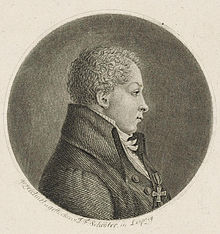Johann Christian Rosenmüller

Johann Christian Rosenmüller (* May 7 or 25, 1771 in Heßberg , Thuringia ; † night of February 28 to February 29, 1820 in Leipzig ) was a German surgeon and anatomist . The Rosenmüller lymph node is named after him.
Life
Johann Christian was the second son of the theologian Johann Georg Rosenmüller (1736–1815). His father gave him a careful upbringing. He received his first lessons in the schools in Königsberg in Bavaria and at the grammar school in Erfurt . At a young age he had developed a great talent in drawing. After a short stay at the University of Giessen , he moved to the University of Leipzig in 1786 , where he obtained a master's degree in philosophy in 1792 . He then began studying medicine at the University of Erlangen and, during his two-year stay there, devoted himself to scientific research with particular passion.
As a student, he attended the first stranger who still bearing his name Rosenmullerhohle in Muggendorf (Wiesenttal) , which he illustrated in the small treatise illustrations and descriptions strange caves in Muggendorf in baruthian Oberland described (Erlangen, 1796). After he defended a dissertation comparing anatomical content in Leipzig in 1794, entitled: Quaedam de ossibus fossilibus animalis cujusdam, historiam ejus et cognitionem accurationem illustrantis (German translation by the author himself, Leipzig 1795), he was appointed prosector at the anatomical theater in Leipzig . In the work described he and the cave bear ( Ursus spelaeus ) based on a well-preserved skull. Rosenmüller earned his doctorate in medicine in 1797, settled as a general practitioner in Leipzig, became a garrison doctor in 1799 and was given the extraordinary (ao) professorship for anatomy and surgery in 1802 .
After the death of Ernst Benjamin Gottlieb Hebenstreit (1758–1803), he moved in 1804 as his successor to the full (top) professorship for surgery, at the same time as an assessor of the medical faculty. From 1806 to 1809 he was a university physicist. In 1819 he was promoted to second professor of anatomy. His scientific and practical work gained increasing recognition. In the summer semesters 1816 and 1818 and in the winter semester 1818 he was elected rector of the Alma Mater . As early as 1809, he resigned as university physicist and took over physics at the law faculty. In 1808 he was accepted into the Minerva Masonic Lodge in Leipzig .
In the last years of his life he suffered from angina pectoris . He died at the age of 49.
Honors
- Royal Saxon Councilor (1811)
- Order of St. Vladimir III. Class (1814)
- Member of the Leopoldina (1818)
- Knight of the Saxon Order of Civil Merit
Works
author
- Partium externarum oculi humani inprimis lacrymalium descriptio anatomica iconibus illustrata . Leipzig 1797, 1810.
- Contributions to the art of dissection . Tauchnitz, Leipzig 1800/02 (3 vol .; with Heinrich Friedrich Isenflamm )
- Quaedam de ovariis embryonum . Leipzig 1803.
- Surgical-anatomical images for doctors and surgeons . Weimar 1804-1812 (3 vols.).
- Programma de Anatomicovum terminis technicis . Leipzig 1811.
- Programma Nervi Obturatorii monographia . Leipzig 1814.
- Manual of anatomy. Based on Lebers “Outline of the Art of Dissection” on the use of lectures . 1815, 3rd edition Leipzig 1819.
- Programmata de viris quibusdam qui in Academia Lipsiensi Anatomes peritia inelaruerunt . Leipzig 1815-1819.
- Compendium anatomicum. Leipzig 1816.
- Programma Prodromus Anatomiae artificibus inservientis . Leipzig 1819.
editor
- Alexander Monro II .: Illustrations and descriptions of the mucous bags of the human body ("Mouroi icones et deseriptiones bursarum mucosarum corporis humani"). Leipzig 1799 (In his additions, Rosenmüller particularly shows the difference between the mucous bellows and mucous sheaths, tests the moisture in these caves chemically, and proves the origin of this mucus from the secretory vessels of their skins)
- John Bell: Dissection of the human body ("The anatomy and physiology of the human body"). Leipzig 1806–1807 (reworked with Johann Christian August Heinroth ). (2 vols.)
- Johann Friedrich Schröter : The human eye in an enlarged representation on a painted board, after Sömmerring , with a short description and preface by J. Chr. Rosenmüller . Weimar 1810
- John Gordon: bone theory for teaching doctors and surgeons ("Engravings of the skeleton of human body"). Baumgärtner, Leipzig 1819
- Karl Gottlob Kühn : Collection of Saxon Medicinal Laws. Second section, continued by J. Chr. Rosenmüller . Leipzig 1820 (with L. Cerutti)
Individual evidence
literature
- Christoph Hamberger , Johann Georg Meusel : The learned Teutschland, or lexicon of the now living German writers. Meyerische Buchhandlung, Lemgo, 1798, Vol. 6, p. 434 ( online ); 1811, Vol. 15, p. 209, ( online ); 1823, vol. 19, p. 428, ( online )
- Johann Nepomuck Rust: Theoretical-practical manual of surgery. Berlin- Vienna 1834, ( online )
- Julius Pagel : Rosenmüller, Johann Christian . In: Allgemeine Deutsche Biographie (ADB). Volume 29, Duncker & Humblot, Leipzig 1889, p. 221 f.
Web links
- Literature by and about Johann Christian Rosenmüller in the catalog of the German National Library
- Overview of the courses held by Johann Christian Rosenmüller at the University of Leipzig (winter semester 1814 to winter semester 1819)
- Johann Christian Rosenmüller in the professorial catalog of the University of Leipzig
| personal data | |
|---|---|
| SURNAME | Rosenmüller, Johann Christian |
| BRIEF DESCRIPTION | German surgeon, anatomist and university professor |
| DATE OF BIRTH | May 7, 1771 or May 25, 1771 |
| PLACE OF BIRTH | Heßberg , Thuringia |
| DATE OF DEATH | February 28, 1820 or February 29, 1820 |
| Place of death | Leipzig |
